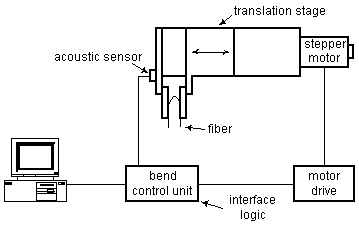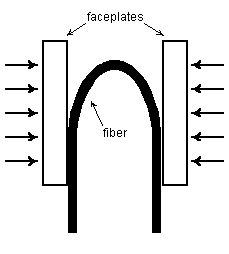|






| |
Two-Point Bend Tester
Purpose
The 2-point bend test is an extremely convenient technique for
determining the strength and fatigue parameters of fibers in general
and high strength optical fibers and ribbons in particular. First
described by Murgatroyd [ref. 1], the technique is
now used extensively in the optical
fiber industry. Reference 2 contains a detailed
description
and evaluation of the method. 2-point bending can rapidly generate
large
quantities of data for routine strength and fatigue measurements and
for
evaluating various polymer coatings.


.JPG)
.JPG)
(click photographs for bigger images)
Description
The 2-point bend test involves placing a loop of fiber bent through
180° between two faceplates. The faceplates are grooved to locate
the fiber in
position. The faceplates are then brought together by a computer
controlled stepper motor translation stage. An acoustic detection
circuit halts the stepper
motor when the fiber breaks. The computer software then calculates the
strength
from the faceplate separation at failure. The system includes:
 |
stepper motor controlled translation stage and controller. |
 |
bending hardware for mounting on the translation stage. Includes
mounting plates and single grooved faceplates for holding a 250
µm coating diameter
polymer coated fiber. |
 |
digital interface designed for connection to the parallel
printer
port of an IBM PC, PS/2 or compatible. Does not require an expansion
slot
if the computer's existing printer port is used. |
 |
computer interface unit also contains a digital position
readout,
manual motor control and acoustic break detector with acoustic
transducer. |
 |
software for complete control of the system from an IBM PC or
compatible. |
 |
miscellaneous software utilities for statistical analysis of
results
and data presentation. |
 | all necessary cables and connectors. |
The control software is extremely powerful featuring:
 |
strength measurement under conditions of constant faceplate velocity,
constant strain rate or constant stress rate. (Only the constant faceplate
velocity mode is available with 2POINT Direct.) |
 |
incorporates a corrections for the non-linear
fiber
elastic modulus. |
 |
a static fatigue mode in which the time to failure is determined
as
a function of the faceplate separation (ref. 3). |
 |
reports strain and stress, faceplate speed, strain rate and
stress
rate at failure and time to failure and all other key experimental
parameters. |
 |
fully configurable by the user both from configuration files and by
menus
- configurable parameters include fiber dimensions and elastic
properties,
faceplate gap for loading fiber, speed parameters, screen menu colors etc.
etc. |
 |
guaranteed to meet all requirements of current standards
(TIA/EIA,
IEC, Bellcore/Telcordia, etc.). |
Click here for a full description of the
2POINT for Windows control program.
Options
- Automatic Fiber Loader
-
An automatic fiber loader option
is
available which permits strength and fatigue measurements to be made
automatically without operator intervention. Click
here for further
information.
- Polished faceplates
-
.JPG)
.JPG)
-
Polished faceplates (FP-POL) are
used
for testing bare fiber and flat fiber ribbons. (Click the above images for
bigger versions.)
- Multi-Groove Faceplates
-
.JPG)
- Multi-V-groove faceplates are
used for
testing up to 12 (FPV-12) or 30 (FPV-30) fibers simultaneously. Note that
fibers must be tested one at a time at the highest loading rates, but
many can be
tested simultaneously at slower loading rates. Total testing time
is controlled by the slowest loading rate used so that multi-groove
faceplates can greatly reduce testing time when making fatigue
measurements for a range of loading rates. (Click the above image
for a bigger version.)
For more detailed information on faceplate options click here.
- Ruggedized System
- An environmentally hardened stepper
motor
and translation stage constructed of stainless steel is available for
testing in harsh environments (TP-8585). The system is guaranteed for
use up to 85ºC,
85% humidity (a test environment specified for some standard test
procedures).
Translation Stage Movement
- The standard system includes a 100 mm
travel, 1 µm per step stepper motor/translation stage. Other travels and
resolutions are available. Please contact us for further information.
Requirements
The system comes complete except that an PC is needed. Requirements:
| 2POINT Pro for Windows |
Minimum requirement is 500 MHz processor, any version of
Windows. Requires a serial or USB port. |
| 2POINT Direct for Windows |
Minimum requirement is 1 GHz processor (3 GHz recommended),
any version of Windows. Requires an available parallel printer port. |
| 2POINT for DOS |
Minimum requirement is a 286 processor running Windows 98 or
earlier. |
The computer requires a parallel printer port (a serial or USB port
is required for 2POINT Pro). A minimum recommended requirement is a 2
GHz PC for 2POINT for Windows (2POINT Direct) but only an i386
processor if needed for 2POINT for DOS.
Specifications
All specifications are for 125 mm glass
diameter silica optical fibers. Contact us for information on other
fiber sizes.
| Maximum loading rate |
5 mm/s
50 %/min
500 MPa/s |
| Maximum displacement (others
available) |
100 mm |
| Positioning error (all sources) |
< 5 µm |
Ordering Information
|
Description |
Part # |
| Complete 2-point bend system (including all
hardware, electronics, cables and software - 2POINT Direct and 2POINT
for DOS) ‡ |
TP-2 |
| 2POINT Pro software and System
Controller for new systems or upgrading existing systems‡ |
2POINT-P |
| 2POINT Direct upgrade for
existing systems‡ |
2POINT-D |
| Ruggedized stainless steel upgrade (guaranteed
for 85ºC, 85% humidity operation)† |
TP-8585 |
| Polished faceplates and clamps for bare fibers
and fiber ribbons (pair) |
FP-POL |
| V-grooved faceplates for 12 fibers (pair) |
FPV-12 |
| V-grooved faceplates for 30 fibers (pair) |
FPV-30 |
| Replacement single V-grooved faceplates (pair) |
FPV-1 |
† must be ordered at the same time as TP-2.
‡ for a
description of the 2POINT Pro for Windows and 2POINT Direct for Windows
software, please click here.

References
-
J. B. Murgatroyd, "The strength of glass
fibres.
Part II. The effect of heat treatment on strength", J. Soc. Glass
Tech.28 388-405, 1944.
-
M. J. Matthewson, C. R. Kurkjian and S. T.
Gulati,
"Strength measurement of optical fibers in bending", J. Am. Ceram.
Soc. 69 [11], 815-821, 1986.
-
M. J. Matthewson & C. R. Kurkjian,
"Static
fatigue of optical fibers in bending", J. Am. Ceram. Soc. 70
[9] 662-668 (1987).
|

